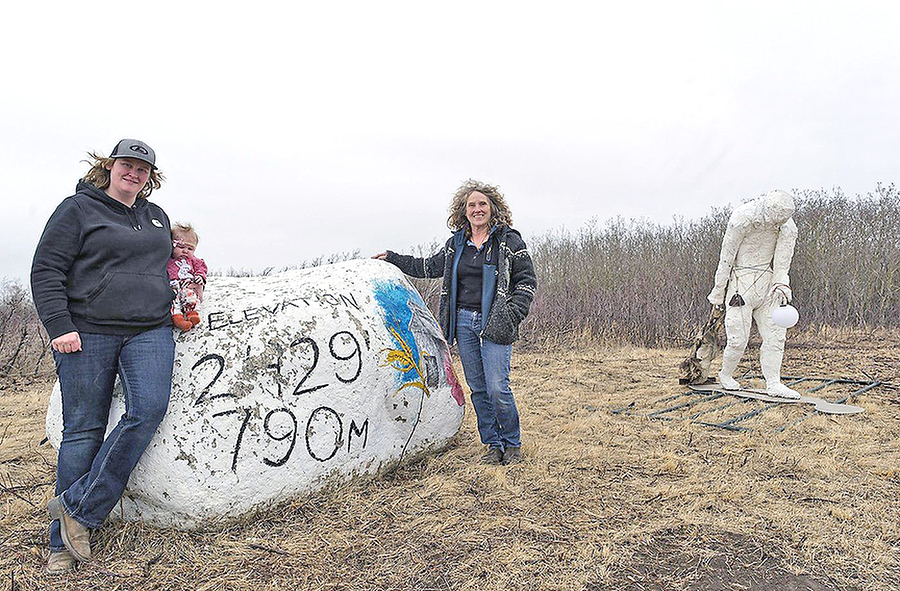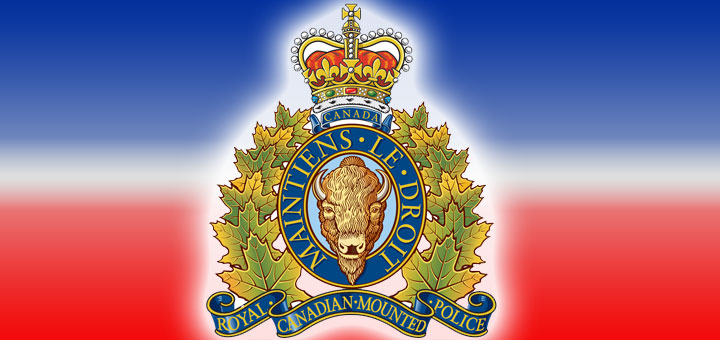Mysterious figure joins famous Alberta landmark

Jesse Boily,
Local Journalism Initiative Reporter
A mysterious figure has joined one of Alberta’s famous landmarks.
East of Grande Prairie along Hwy. 43 has sat a large rock painted in white with text that reads “Elevation 2429 790M.” A grain elevator is depicted beside it.
In October, a figure of a person standing next to the locally famous rock appeared. Its head, pointed down, in an almost solemn walk carrying a lantern.
“It’s supposed to be a soldier, carrying his parachute,” wrote a social media commenter. Another commenter wrote that it’s a Halloween decoration. “I thought it was like a mummy or something.”
“At first, I thought it was a guy dragging a body holding the head in the other hand,” reads another.
All of them are wrong.
The figure is known as Bob, named by its creator, local artist Alysoun Wells.
“I see on social media, every now and then, people talking about Bob; I never chime in because I like to hear what people have to say,” chuckles Alysoun.
“I was going to do a series of dejected figures sitting or standing and looking like they’d lost all hope, all cause, but there’s going to be a light behind them that they couldn’t see,” she said.
“So his light was in his suitcase, so he’s dejected and travelling through the world with no hope, but there’s always hope; that light is hope.”
The statue has since gained the name Bob Hope. The suitcase Bob carries hasn’t survived the weather, so now he holds a lantern to light the darkness.
Alysoun and her family have become the caretakers of the rock that sits on their property.
She said they had thought of putting a light next to the elevation rock for a while and figured, why not put Bob there? He has a light, after all.
The sculpture has reignited people’s imaginations about where Bob came from and the history of the rock.
Alysoun has been looking after Elevation Rock since 2004.
Rumours about the rock circulate occasionally on social media and in chats about the Peace Country; some say it marks a car crash and some simply use it as a marker that they are close to home from a long trip. For others, it’s just what’s always been there.
The rock is no stranger to publicity and has been talked about in newspapers of days past.
In 1973, a photo of Elevation Rock appeared in the Daily Herald Tribune. The rock looks a bit different today. It was then painted white and read “ELEVATION 2420,” with wild roses painted at the base. The caption claims the rock is “an example in the beauty of the region, even if it happens to be a large rock.”
The historical rock goes back to one settler’s fascination with the local area’s elevation.
Robert Cochrane arrived in the Grande Prairie area in 1910. He acquired 1,280 acres of land, creating the largest farm in the area at the time.
“Cochrane prospered as a farmer; in 1928 and 1931, he produced what was judged to be the best alfalfa and timothy in the world, winning him international acclaim and attracting settlers to the Peace Country,” reads the Canadian Register of Historic Places account of Cochrane.
Cochrane also became interested in paleontology and geology, creating a collection of fossils from the Kleskun Hills area.
Cochrane began holding geological picnics at Kleskun Hill in 1946.
He eventually learned that a spot of his land was a higher elevation than a marked spot in the mountains of Prince George, B.C. Verna Crowe recounted in a 2004 Peace Country Sun article.
She said Cochrane wanted to use the large rock as a point of interest for locals and to remind them the prairies were at a higher point than the mountains to the west.
He had the large rock placed next to the then Hwy. 34 and painted it white with the expectation of having a sign eventually there explaining it all. But, Cochrane’s health took a turn when he had a stroke in 1963.
“He couldn’t talk, but he could write, and he wrote to me one time asking me who could look after that rock and put the elevation sign on it.
I said, ‘Oh, Grandpa, I’ll look after that,’ and he just beamed,” Crowe told the Peace Country Sun in 2004.
“Everybody called him Grandpa Cochrane,” recalls Janet Laverick, Crowe’s daughter. Cochrane’s son married Crowe’s sister, and he was well-known in the community.
Cochrane would pass away in 1965, knowing that his rock was in the safe hands of Crowe.
Janet said her mother would continue to paint the rock – because she promised Cochrane she would – and she thought it was a pretty landmark.
Janet remembers going to the rock with her mother. After it was cleaned, Crowe would paint her roses on it.
Janet said Crowe’s sister would also occasionally paint the rock with her.
Crowe would go to the rock and repaint it for many years.
As her age caught up with her, she began to worry about who would look after the rock. She eventually met the new landowners. Allysoun and her husband Smith began taking care of the rock with their children.
Now, Alysoun’s daughter Erin Burns-Wells taken over the task, having completed the last two paint jobs.
“I hope this is something we don’t see get absorbed or left behind,” said Erin as she looked out to the west, where the city’s sprawl of industrial parks continues to draw closer to the landmark.
For Erin, it’s a huge honour to care for the rock, and she hopes to eventually share the experience of caring for the Peace Country landmark with her child, Ferrah Burns, just three months old.
She even has the rock tattooed on her, representing a bit of her Alberta.
“It’s been a big part of my childhood. We came up here, and we had family picnics a lot while my mom was painting it; I remember bringing up the picnic basket and picking saskatoons,” said Erin.
Jenny Laverick, the granddaughter of Crowe, honours the rock as it’s her Bezanson business logo.
“I think it’s important to everybody around here that the rock is kept up just because we all know that it is a landmark and so many people use it and know it,” she said.
The rock is also a place of remembrance for some, and two crosses sit next to the rock.
Bonnie Deane remembers an car accident that took place nearby and recently found a newspaper clipping in her Bible. On November 19, 1997, Dennis Calvert, 31, lost control of his car and hit Marguerite Brown’s, 53, vehicle with passenger Orlee Lawson, 71. All three were pronounced dead at the scene.
The one thing for certain is the rock means many things to different people around the Peace.
For now, Bob is bringing it new attention.
“His job is to be a guiding light,” said Erin.
Jesse Boily,
Local Journalism Initiative Reporter
Town & Country News






